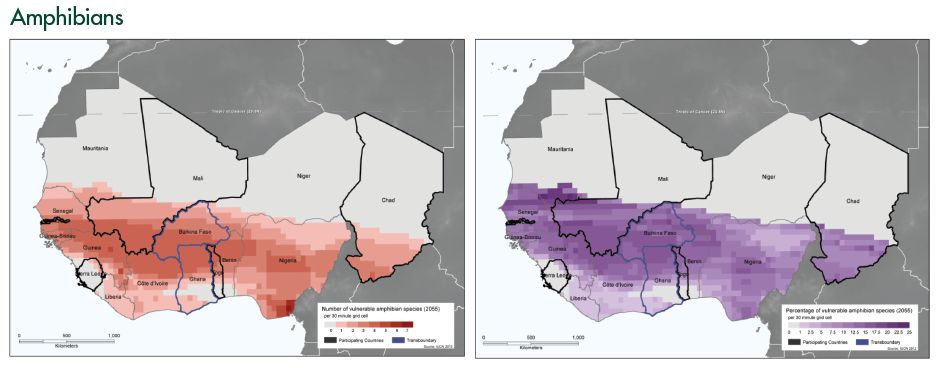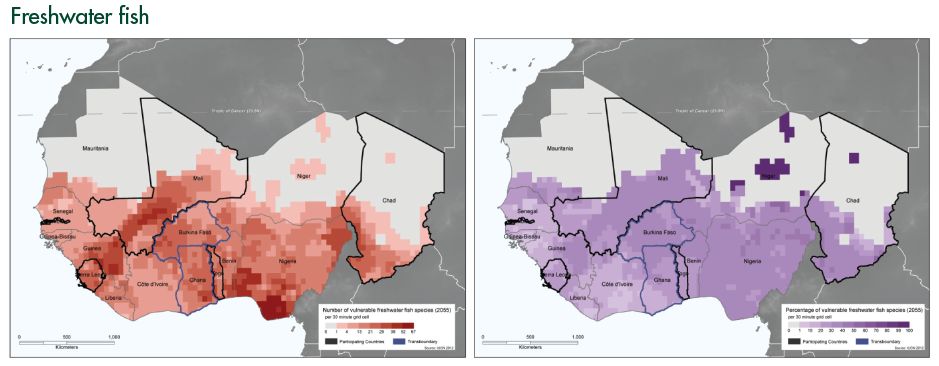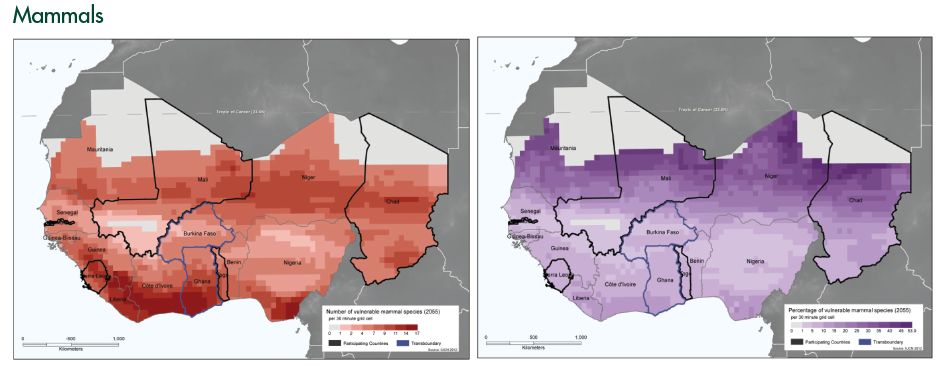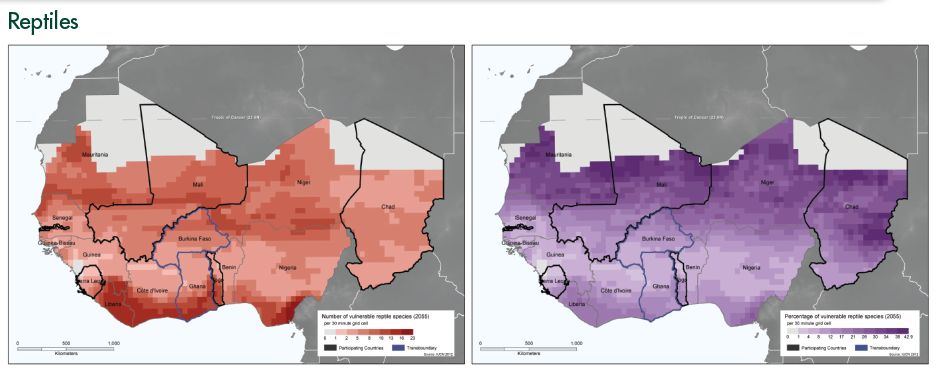Key findings: A number of West African species (including amphibians, birds, freshwater fish, mammals and reptiles) have been identified as vulnerable to climate change, based on their specific biological and ecological traits. Of these species, those that have been assessed as globally threatened should be considered priorities for conservation.
IUCN Global Species Programme applied a different methodology, called Traits-based Vulnerability Assessments (TVAs), which allowed them to assess the vulnerability of species to climate change based on their specific biological traits, without taking into account spatial aspects of species distributions.
Through two expert workshops, held in Lomé, Togo, with national and international experts, as well as remote consultations, and using data available from previous projects, species biological and ecological trait data were collated for 183 amphibians, 1,172 birds, 517 freshwater fish, 405 mammals and 307 reptiles. These data were used to infer, for each individual species, their 'sensitivity' and 'adaptive capacity' to climate change.
Species distribution polygons, collated through the process of assessing species for the IUCN Red List, were overlaid with future climate projections provided by the UK Met Office Hadley Centre to determine the changes in the means and variability of temperature and precipitation that each species may be exposed to. Species that are both considered sensitive and poorly able to adapt to climate change, and are among the most severely exposed to climatic changes, were described as 'climate change vulnerable'.
The number of species qualifying under each component of our assessment framework was calculated for all individual biological traits used and for each individual framework 'dimension' (sensitivity, adaptability and exposure) (Figure 10), as well as the total number of species considered climate change vulnerable. Based on these results, maps were created highlighting the broad geographical areas that contain high numbers and/or proportions of climate change vulnerable species within a given taxon (Figure 11). This information can help conservationists identify the most prevalent mechanisms through which climate change may impact upon each taxonomic group in the region, and can inform the development of suitable adaptation actions for species or groups of species.

Greatest climate change vulnerability occurs where species face highest Exposure to climatic change, and also possess biological traits that confer both Sensitivity and Low adaptability to such change.
Amphibians
Overall, a total of 12 (7%), 18 (10%) and 46 (25%) amphibian species are considered climate changevulnerable by the time periods 2010-2039, 2040-2069 and 2070-2099, respectively, based on regional climate projections and an optimistic assumption of missing data values. In terms of proportions, our assessments suggest that by the time period 2040-2069 the greatest impacts will occur in the more northern arid and semiarid regions. By 2070-2099, increasing proportions of vulnerable species are visible in the more southern and typically humid zones. Of the species identified as climate change vulnerable by 2040-2069, only one species, Amietophrynus perreti, is globally threatened.





Distribution of climate change vulnerable West African species by the time period 2040-2069. Total number of species per grid cell assessed as climate change vulnerable (Left) and percentage of species in each grid cell assessed as climate change vulnerable (right).
Birds
Overall, a total of 17 (1.5%), 247 (21%) and 309 (26%) bird species are considered climate changevulnerable by the time periods 2010-2039, 2040-2069 and 2070-2099, respectively, based on regional climate projections and an optimistic assumption of missing data values. In terms of proportions, our assessments suggest that by 2040-2069 the greatest impacts will occur in the southern humid zone, as well as in the northern arid zone (from Mauritania in the West, to Chad in the East), where up to 31% of the species present were assessed as climate change vulnerable. Of the species identified as climate change vulnerable by 2040-2069, 13 species are globally threatened.
Freshwater fish
Overall, a total of 99 (19%), 202 (39%) and 311 (60%) freshwater fish species are considered climate change-vulnerable by the time periods 2010-2039, 2040-2069 and 2070-2099, respectively, based on regional climate projections and an optimistic assumption of missing data values. In terms of proportions, our assessments suggest that by 2040-2069 the greatest impacts will occur in the desert regions of northern Niger and Chad, where all freshwater species are assessed as climate change vulnerable. By 2070-2099, areas in the east of Mauritania and in the east of Mali also stand out, with over 80% of their freshwater fish fauna vulnerable. Of the 202 species identified as climate change vulnerable by 2040-2069, 62 are globally threatened.
Mammals
Overall, a total of 22 (5%), 63 (16%) and 115 (28%) mammal species are considered climate changevulnerable by the time periods 2010-2039, 2040-2069 and 2070-2099, respectively, based on regional climate projections and an optimistic assumption of missing data values. In terms of proportions, our assessments suggest that by 2040-2069 the greatest impacts will occur in the northern, desert regions of Mauritania, Mali, Niger and Chad, where up to 54% of species were assessed as climate change vulnerable. Of the 63 species identified as climate change vulnerable by 2040-2069, eight are globally threatened.
Reptiles
Overall, a total of 22 (7%), 66 (21%) and 104 (34%) reptile species are considered climate changevulnerable by the time periods 2010-2039, 2040-2069 and 2070-2099, respectively, based on regional climate projections and an optimistic assumption of missing data values. In terms of proportions, our assessments suggest that by 2040-2069 the greatest impacts will occur in the Sahel and desert regions of Mauritania, Mali, Niger and Chad, where more than 40% of species were assessed as climate change vulnerable. Of the 66 species identified as climate change vulnerable by 2040-2069, three are globally threatened (although 41 have not been evaluated for the IUCN Red List).
The maps displaying the geographic areas that contain high numbers and/or proportions of climate change vulnerable species within a given taxon can be used to determine where conservation measures to reduce the impacts of climate change may be most urgently required, as well as where such measures may be most effective in reducing impacts for the greatest number and/or highest proportion of species.
For each taxonomic group, this study also showed the extinction risk, according to the IUCN Red List of Threatened Species, including maps showing densities of threatened species across the region. Species that are both globally threatened and vulnerable to climate change should be seen as top priorities for conservation action. Similarly, species that are only one of threatened or climate change vulnerable should also receive attention, though the specifics of these will vary depending on the outcomes of the assessments. Species that are considered Data Deficient on the Red List and/or were unable to be assessed in terms of climate change vulnerability due to insufficient information should be seen as priorities for research in order to determine the levels of risk that they may face.
Finally, broad examples of ways in which vulnerability assessments can be used to develop conservation strategies are presented. It is hoped that practitioners will consider these findings on a species-by-species basis, and use them to modify existing, or develop new, conservation approaches which explicitly address climate change impacts upon species.











